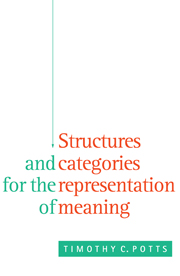Preface
Published online by Cambridge University Press: 23 September 2009
Summary
This work addresses the representation problem – to use the jargon of computer scientists. To be sure, they speak of the representation of knowledge, but that is a misnomer, reflecting their intentions rather than the nature of the problem. What counts as knowledge must be true, yet any notation in which we can express what is true must equally allow us to express what is false. The problem, therefore, is how best to represent the meanings of linguistic expressions so that they may be manipulated in accordance with rules, such as rules of inference or of translation. One might call this the ‘semantic form’ of expressions, by analogy with ‘logical form’.
My interest is restricted to expressions of everyday language. This is not a synonym for ‘natural language’. The implied contrast is with technical language, for example the language of mathematics, which might also qualify as natural language. I also assume that, in the case of expressions which are accounted either true or false (propositions), the central core of their meanings will be given by specifying the circumstances under which they would be true, so that semantic form or structure will relate to and should facilitate these specifications.
Identifying the structure is, indeed, the very first step in such a specification, for the meaning of an expression is determined by the meanings of its parts and the manner of their combination; that much is implicit in the possibility of learning a language (see Davidson, 1965).
- Type
- Chapter
- Information
- Structures and Categories for the Representation of Meaning , pp. xi - xivPublisher: Cambridge University PressPrint publication year: 1994

